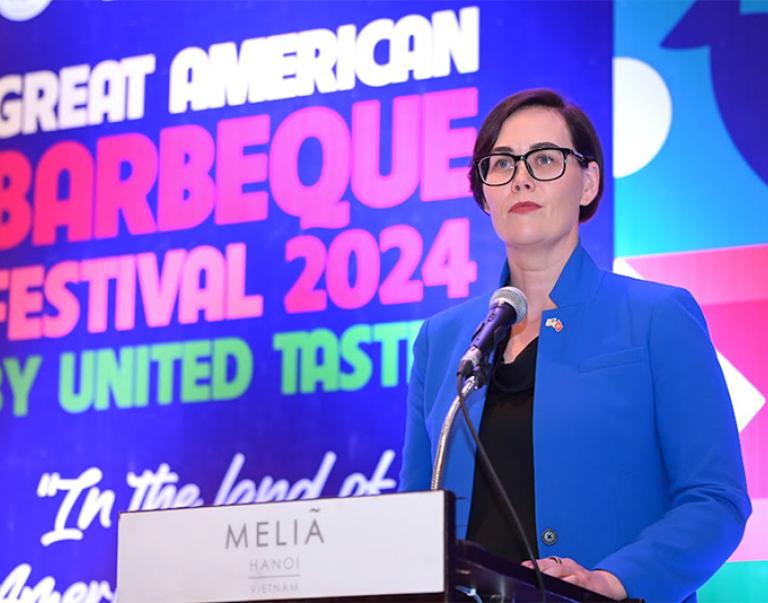PHILADELPHIA, June 25, 2015 – Supplemental Nutrition Assistance Program (SNAP) participants are spending more of their benefits to make purchases at roadside farm stands, farmers markets and directly from local farmers than ever before. SNAP redemptions at those outlets in FY14 totaled $18.8 million, a nearly six-fold increase since 2008. Agriculture Under Secretary Kevin Concannon will laud the increase during a visit today to Philadelphia's Clark Park Farmers Market.
"All Americans, including those participating in our nutrition assistance programs, need to include more fresh fruits and vegetables in their diet. America's farmers have an important role to play in addressing that need in communities across the country," Concannon said. "Accepting SNAP benefits also increases the customer base for local producers, adding an extra economic boost to the community."
Since 2008, the number of SNAP-authorized farmers, roadside farm stands, and farmers markets grew dramatically, from 753 to in excess of 6,400, more than eight times the number these types of vendors accepting SNAP when the Obama Administration took office.
"These increases did not just happen," Concannon said, emphasizing that expanding access for SNAP recipients to the fresh produce available at these outlets has been a top priority for the U.S. Department of Agriculture (USDA).
Through a partnership with the National Association of Farmers Market Nutrition Programs, USDA provides free wireless equipment to qualifying farmers and farmers markets, enabling them to accept SNAP via electronic benefit transfers (EBT). Additionally, in May, USDA announced the availability of $3.3 million in competitive funding to help farmers markets serve SNAP participants. These Farmers Market SNAP Support Grants are the latest example of USDA's ongoing commitment to improving the diet and health of all Americans, but with particular concern for low-income families. Those awards will be announced in September.
USDA also recently awarded $31.5 million in funding to local, state, and national organizations to support programs that encourage SNAP participants to buy more fruits and vegetables, including the fresh produce found at America's farmers markets and direct marketing farm outlets. Funded through the Food Insecurity Nutrition Incentive (FINI) program authorized by the 2014 Farm Bill, the projects will help policymakers determine how best to provide incentives to SNAP participants to increase healthy purchases.
Farmers are a vital lifeline to healthy nutrition in low-income areas, because many bring their products to "food deserts" with few, if any, supermarkets or grocery stores. "Redemptions through farmers and producers nourish local economies, while helping those in underserved neighborhoods," Concannon said. "Without farmers markets, roadside farm stands and farmers who sell directly to the public, residents of these communities may have to travel to grocery stores outside their area to obtain fresh produce or make-do with processed foods."
Yael Lehman, executive director of The Food Trust in Philadelphia, said that over the last three years, SNAP sales rose by more than 300 percent at its farmers markets in the city's lowest-income areas. "By promoting and accepting SNAP and other food assistance benefits like Philly Food Bucks, we can make fresh food affordable for children and families across the region," Lehman said.
The Food Trust in Philadelphia began 23 years ago with one farm stand in Grays Ferry, a South Philadelphia neighborhood where it was hard to find fresh produce. In 2014, The Food Trust's 27 farmers markets, including the Clark Park Farmers Market, served more than 400,000 customers throughout the Philadelphia area. The Food Trust was one of the recipients of the FINI grants awarded earlier this year. In Philadelphia, the FINI grant supports the Philly Food Bucks program, which provides SNAP participants with a $2 coupon for fresh fruits and vegetables for every $5 in SNAP benefits used at a participating market.
Expanding access to local food is a cornerstone of the USDA's Know Your Farmer, Know Your Food Initiative which coordinates the department's work on strengthening local and regional food systems. Agriculture Secretary Tom Vilsack has identified local and regional food systems as one of the four pillars of rural economic development, along with production agriculture, the bio-based economy, and natural resources and conservation.
USDA's Food and Nutrition Service administers 15 nutrition assistance programs. In addition to the Supplemental Nutrition Assistance Program, these programs include Special Supplemental Nutrition Program for Women, Infants and Children, the National School Lunch Program, and the Summer Food Service Program which together comprise America's nutrition safety net. For more information, visit www.fns.usda.gov.
#
USDA is an equal opportunity provider and employer. To file a complaint of discrimination, write: USDA, Office of the Assistant Secretary for Civil Rights, Office of Adjudication, 1400 Independence Ave., SW, Washington, DC 20250-9410 or call (866) 632-9992 (Toll-free Customer Service), (800) 877-8339 (Local or Federal relay), (866) 377-8642 (Relay voice users).



